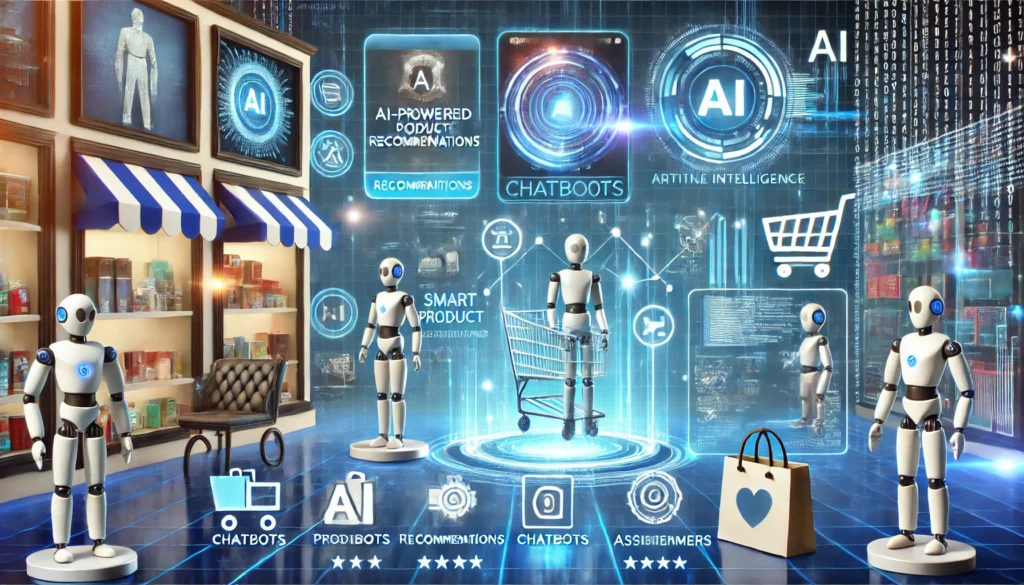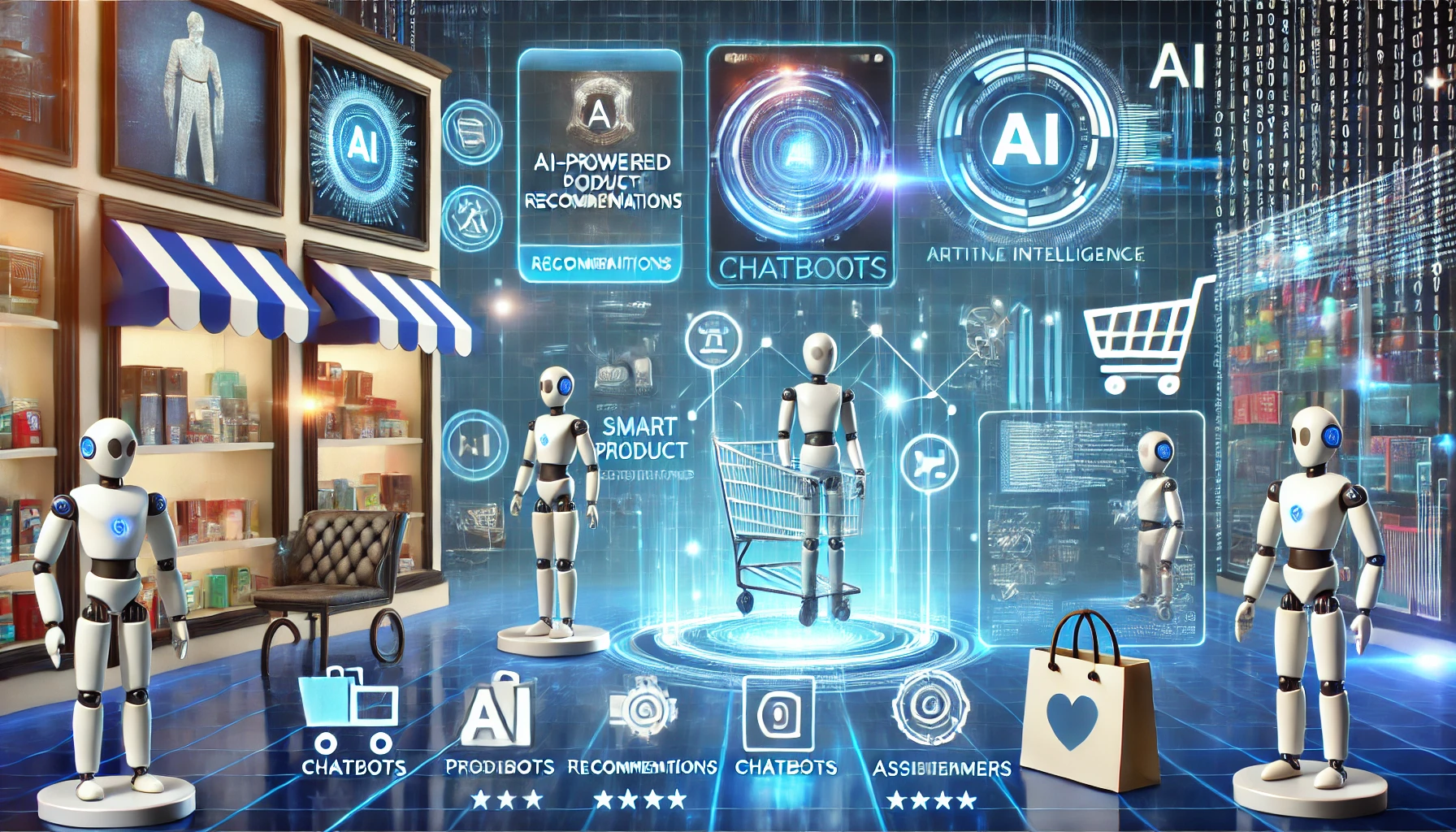Introduction

Imagine walking into a virtual store where every product seems handpicked just for you, where customer support is instantaneous, and where pricing feels perfectly tailored to your budget. This isn’t a futuristic dream—it’s the current reality of AI in e-commerce, a technological revolution transforming online shopping as we know it.
In 2025, artificial intelligence will become the backbone of successful online retail strategies. From small boutique shops to global e-commerce giants, businesses are leveraging AI to create more personalized, efficient, and intelligent shopping experiences. According to Gartner’s 2024 Retail Technology Report, over 65% of e-commerce businesses now integrate some form of AI technology into their operations.
This comprehensive guide will explore how AI is reshaping online shopping, delving into its benefits, challenges, real-world applications, and future trends that are revolutionizing the e-commerce landscape.
Table of Contents
Background & Importance of AI in E-Commerce
Defining AI in E-Commerce
Artificial Intelligence in e-commerce refers to the use of advanced machine learning algorithms, predictive analytics, and intelligent automation to enhance various aspects of online retail. It’s not just about replacing human interactions but augmenting them with data-driven insights and personalized experiences.
AI Adoption Statistics
Recent research paints an impressive picture of AI’s impact:
- McKinsey reports that AI could generate up to $1.4 trillion in additional value for the retail industry by 2025.
- The global AI in retail market is projected to reach $31.18 billion by 2028, growing at a CAGR of 26.5%.
Key Benefits & Challenges of AI in E-Commerce
Top Benefits of AI in E-Commerce
1. Enhanced Customer Personalization
AI algorithms analyze customer browsing history, purchase patterns, and preferences to create hyper-personalized shopping experiences. For instance, Amazon’s recommendation engine generates 35% of its total sales through personalized product suggestions.
2. Automated Inventory Management
Tools like IBM Watson Supply Chain Insights use AI to predict inventory needs, reducing stockouts and overstock situations by up to 50%. Walmart, for example, uses machine learning to optimise its inventory across thousands of stores.
3. AI-Driven Pricing Strategies
Platforms like Price f(x) help businesses dynamically adjust prices based on market demand, competitor pricing, and customer behavior. Airlines and e-commerce giants have been using such technologies for years to maximize revenue.
4. Improved Customer Support with AI Chatbots
Intercom and Drift provide AI-powered chatbots that handle up to 80% of routine customer inquiries, reducing response times and operational costs.
5. Fraud Detection and Prevention
Machine learning models can detect suspicious transactions with 95% accuracy, significantly reducing online payment fraud.
Common Challenges & Solutions
Data Privacy Concerns
- Implement transparent data usage policies
- Use anonymized data for AI training
- Comply with regulations like GDPR and CCPA
Implementation Costs
- Start with affordable AI tools
- Use scalable cloud-based solutions
- Gradually integrate AI technologies
Balancing AI and Human Interaction
- Use AI to handle routine tasks
- Maintain human oversight for complex issues
- Train staff to work alongside AI systems
Real-World Use Cases & Applications
Case Studies: AI Leaders in Action
Amazon’s AI-Powered Ecosystem
Amazon uses machine learning for:
- Product recommendations
- Demand forecasting
- Prime delivery route optimization
- AWS machine learning services for other businesses
Shopify’s AI Innovations
Shopify’s Sidekick AI assists merchants by:
- Generating product descriptions
- Offering business insights
- Recommending marketing strategies
How AI Recommendation Engines Work
Step-by-step breakdown of a typical recommendation system:
- Data Collection: Gather user interaction data
- Pattern Recognition: Identify similar user behaviors
- Collaborative Filtering: Recommend products liked by similar users
- Continuous Learning: Refine recommendations based on new data
Expert Insights & Thought Leadership
“AI is not about replacing human creativity but amplifying it. In e-commerce, it’s a powerful tool that helps businesses understand and serve customers more effectively.” – Dr. Emily Chen, AI Ethics Researcher at Stanford University
Implementing AI in Your Online Store: A Practical Guide
- Assess AI Needs
- Identify specific business challenges
- Set clear, measurable goals
- Choose AI Tools
- Chatbots: Intercom, Drift
- Analytics: Google Analytics AI, Heap
- Automation: Zapier, Microsoft Power Automate
- Integrate with Existing Platforms
- Ensure compatibility
- Use API-friendly solutions
- Continuous Testing & Optimization
- Monitor AI performance
- Gather user feedback
- Regular algorithm updates
Step-by-Step Guide or Action Plan
How to Implement AI in an Online Store
1. Assess AI Needs & Set Goals
Before investing in AI solutions, e-commerce businesses should:
- Conduct a pain point analysis: Identify specific business challenges AI could address, such as high cart abandonment, excessive returns, or inefficient customer service.
- Establish clear KPIs: Define measurable goals for your AI implementation, such as “reduce customer service inquiries by 30%” or “increase average order value by 15%.”
- Inventory existing data: Assess what customer data you already collect and identify gaps that need to be filled for effective AI implementation.
- Evaluate technical readiness: Determine if your current e-commerce platform can integrate with AI solutions or if upgrades are needed.
Real-life example: Home goods retailer Wayfair began its AI journey by focusing specifically on its product search functionality, where internal data showed customers were struggling to find items they were looking for. They set a goal of reducing “no results found” searches by 50% and implemented an AI-powered semantic search solution that achieved a 48% reduction within three months.
2. Choose AI Tools (Chatbots, Analytics, Automation Software)
With clear goals established, the next step is selecting the right AI tools:
- Start with high-impact, low-complexity implementations: Recommendation engines and basic chatbots typically offer the fastest ROI.
- Consider platform integrations: Many e-commerce platforms offer native AI capabilities or straightforward integrations:
- Shopify: Kit, Shop AI, Flow
- WooCommerce: Jetpack AI, Conversios
- Magento: Adobe Sensei integration
- BigCommerce: Bloomreach, Constructor integrations
- Evaluate build vs. buy: While custom AI solutions offer maximum flexibility, off-the-shelf options provide faster implementation and proven results.
- Assess total cost of ownership: Beyond initial implementation, consider ongoing costs for data storage, model training, and technical maintenance.
Real-life example: Outdoor retailer REI started with a simple AI chatbot from Ada that handled basic customer inquiries. The success of this implementation (65% of customer questions resolved without human intervention) provided both ROI and organizational confidence to expand into more complex AI applications like visual search and inventory optimization.
3. Integrate AI with Existing E-Commerce Platforms
Successful integration requires careful planning and execution:
- API assessment: Evaluate the quality and completeness of APIs available for your chosen AI solution and e-commerce platform.
- Data pipeline creation: Establish reliable flows of customer, product, and transaction data to your AI systems.
- Testing environment: Create a staging environment to test AI implementations before they go live to customers.
Debunking AI Myths in E-Commerce
Myth #1: AI Will Replace Human Jobs
Reality: AI creates new roles and enhances existing ones, focusing on strategy and creativity.
Myth #2: AI is Too Expensive for Small Businesses
Reality: Many affordable AI tools cater to businesses of all sizes, with scalable pricing models.
Myth #3: AI Lacks Accuracy and Personal Touch
Reality: Modern AI continuously learns and improves, becoming more nuanced and personalized.
Future Trends & Predictions
Emerging AI Technologies in E-Commerce
- Virtual shopping assistants
- Voice commerce integration
- Sustainable AI-driven supply chains
- Augmented reality shopping experiences
Conclusion: Embracing the AI-Powered Future of E-Commerce
AI in e-commerce is not just a trend—it’s a fundamental transformation of how we shop online. By understanding and strategically implementing AI technologies, businesses can create more intelligent, efficient, and customer-centric shopping experiences.
Call to Action
- Share your AI e-commerce experiences in the comments
- Explore AI tools for your business
- Stay informed about the latest AI innovations
Related Articles:
- The Future of Machine Learning in Retail
- AI-Driven Customer Experience Strategies
- Sustainable E-Commerce with Artificial Intelligence
Conclusion & Call to Action
Key Takeaways from the Article
AI has firmly established itself as a transformative force in e-commerce, reshaping how online stores operate and how customers shop:
- AI is no longer optional for competitive e-commerce. With giants like Amazon and innovative startups alike leveraging artificial intelligence, businesses that delay adoption risk falling behind in customer experience, operational efficiency, and market share.
- AI implementation is now accessible to businesses of all sizes. Through platform integrations, SaaS solutions, and graduated implementation strategies, even small retailers can harness powerful AI capabilities without enterprise-level budgets.
- The most successful AI strategies balance automation and human elements. Rather than replacing human jobs, effective AI implementations enhance human capabilities, allowing staff to focus on creative, strategic, and emotionally complex aspects of e-commerce.
- Customer expectations are being shaped by AI-powered experiences. As shoppers encounter sophisticated personalization, instant support, and frictionless interactions with leading retailers, these expectations transfer to all their online shopping experiences.
- AI in e-commerce continues to evolve rapidly. From voice commerce to virtual shopping assistants to sustainability applications, the next wave of AI innovations promises even more profound changes to online retail.
Engage with the Conversation
This article represents just the beginning of an ongoing exploration of AI in e-commerce. We invite you to:
- Share your experiences in the comments below. Have you implemented AI in your online store? What results have you seen?
- Ask questions about specific AI applications or technologies mentioned in this article. Our team and community members can provide additional insights.
- Connect with experts who specialize in e-commerce AI implementation. Many of the case studies mentioned here started with a simple conversation about possibilities.
- Subscribe to our newsletter for regular updates on emerging AI technologies and how they can be applied to online retail.
Explore Related Resources
Ready to dive deeper into AI for e-commerce? Check out these related resources:
- The Complete Guide to A/B Testing AI Implementations in E-Commerce
- How to Choose the Right AI Chatbot for Your Online Store
- Case Study: How Medium-Sized Retailers Are Achieving 40%+ Growth with AI
- AI Privacy Compliance: What Every E-Commerce Business Needs to Know
- Free Webinar: Getting Started with AI Personalization on a Limited Budget
The AI revolution in e-commerce is well underway, transforming not just how we sell online but how customers discover, evaluate, and purchase products. By understanding and thoughtfully implementing AI technologies, online retailers of all sizes can enhance customer experiences, streamline operations, and drive substantial revenue growth in 2025 and beyond.




